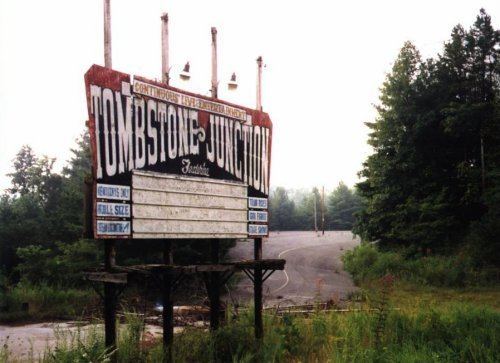 | ||
Similar Big South Fork Scenic R, Cumberland Falls State Resort Pa, Ark Encounter, Kentucky Kingdom, Eagle Falls | ||
Tombstone Junction was a small western town themed park located on Kentucky Route 90 in McCreary County, Kentucky near Cumberland Falls State Resort Park. It began operating in the 1960s and continued uninterrupted until the park was heavily damaged by fire in 1989. After this first fire, the park continued with limited operation until it was completely destroyed by a second fire in 1991. The park featured a recreation of a small western frontier town complete with train station, working saloon, dance hall, jailhouse, shanty's, and shops. There was also an outdoor amphitheater which hosted live shows featuring country and western music of the period.
Contents
- Hi tide band plays at tombstone junction amusement park rare footage
- Background
- Country Western environment
- Old 77
- Rail equipment
- Stage shows
- Decline
- End of the park
- The park today
- Photos and video
- References

The leading attraction at Tombstone Junction was a full-sized standard gauge operating steam train.
Hi tide band plays at tombstone junction amusement park rare footage
Background

The park developed from the building and operation of the "Cumberland Falls Scenic Railroad" in the 1960s. The railroad was built by Millard and Morris Stephens from nearby Whitley City as an attraction to compliment The Falls Motel (which they owned) which was near Cumberland Falls State Resort Park, both of which were a very short distance down the road.
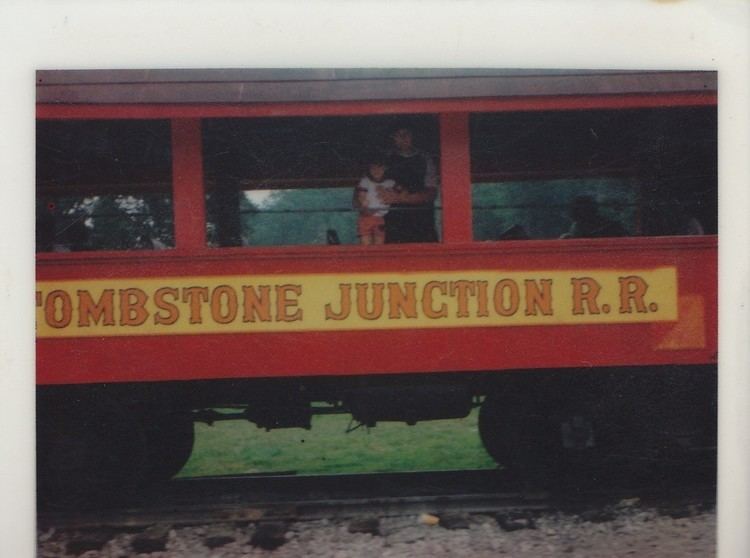
The railroad was built and laid around the edges of a large cut between two mountains that had been filled in enough so that a 2½ mile "L" shaped circle of track could be laid. This was almost a copy of the idea behind the "Rebel Railroad" in Pigeon Forge, Tennessee which eventually grew into what is known as the Dollywood themepark today.
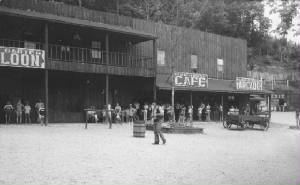
For the second season of operation, the railroad's developers made in-house additions of buildings, shops, and The Red Garter Saloon using help from the local residents. The various stages of development of a functional park were planned out with each season adding new attractions, shops, stores and shows. The town portion of the park went by the operating name of "Tombstone Junction" and the railroad went by the operating name of "Old #77". However, the corporate name for the entire operation was "Cumberland Falls Scenic Railroad, Inc." Locals referred to the park as simply "The Junction."
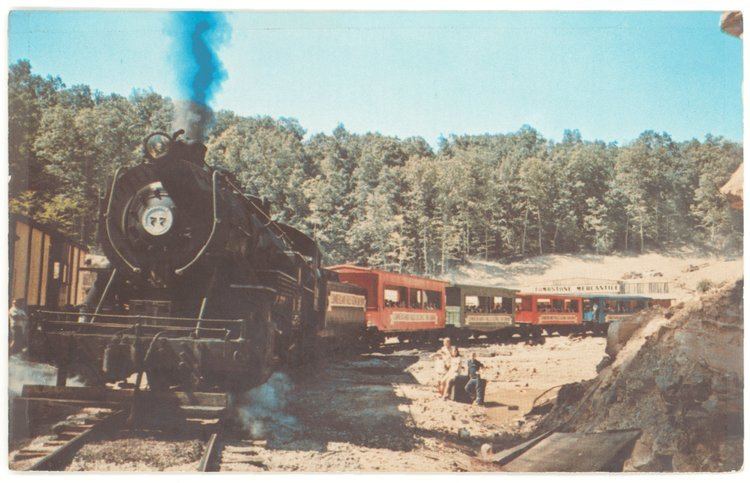
It is interesting to note that the mailboxes in the town's post office were from the post office where Sgt. Alvin York received his draft notice. This moment was made famous in a dramatic scene in the movie, "Sgt. York," which was based on his journey struggling with being drafted into service in WW 1 as he was a conscientious objector based on religious beliefs to becoming a Congressional Medal of Honor winner due to his service of valor in the war.
Country Western environment
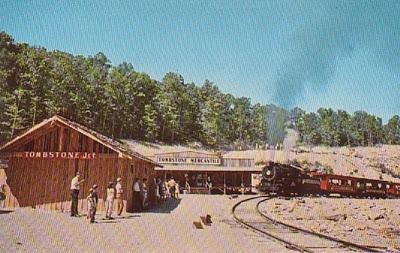
Local residents were also used as characters to populate the "town" of Tombstone Junction. The local community was very involved in the park. The park focused on audience-involving stage shows, gunfights, music shows, and a group of gunfighters who interacted with the visitors.
The Junction was perhaps most known for bringing nationally known entertainers to the South Central Kentucky area and offering family entertainment to the area for a reasonable price. Entertainers such as The Judds, Randy Travis, Dolly Parton, Kenny Rogers, Barbara Mandrell, Conway Twitty, and Loretta Lynn were part of the Sunday Concert Series that took place every Sunday from April to October. Every Sunday brought a famous recording artist or band to The Junction and they performed on the Outdoor Stage.
Old #77
The park's biggest attraction was "Old #77", a full-sized fully operational steam train.
Passengers boarded and departed at the park's only station. This was situated almost directly in the center of the park and served as a focal point for the rest of the operation. The station also housed the park's business offices where files were kept and housed an extensive collection of autographed photos from stars that had visited the park.
The route was a 2½ mile "L" shaped circle track with the town of Tombstone Junction on one end that traveled through the wooded hills of the Falls area and came back again. The line featured steep overlooks, sharp turns, and rough track. It was actually a very close representation of what riding a hastily laid start of the 20th century rail line would have been. The 180-degree turn the line made in front of the train station was so tight that running the locomotive through it proved problematic sometimes. When the locomotive was being operated by engineer Bill Johnson and fireman Don Vanover, it derailed next to the amphitheater stage just prior to the start of a Loretta Lynn performance. This was at the top of the 8% grade that the train had to pull which made re-railing the locomotive difficult.
At the halfway point, the ride featured a train robbery where the train was stopped by "bandits" who would rob the train until the Tombstone Junction sheriff rode up and had a drawing match with the ringleader. The winner varied. The "robbery" was held at the bottom of the grade and was not only for the entertainment of the tourists, but also gave the engine crew time to service the engine and build a full head of steam to pull the steep mountain grade which started at 4%, then 6%, then a section of 8%.
Rail equipment
The park owned three steam locomotives. When the railroad was originally built in the 1960s two former U.S. Army 0-6-0 saddle tank locomotives were brought in with the idea that they would power the train ride. However, the steep grades proved too much for these engines and their use was abandoned almost from the start. They were sidelined to a sidetrack and displayed next to the railroad shop building for several decades until the parks closing.
The third engine and the one that proved powerful enough to pull the train was a 90-ton 0-6-0 ALCO switcher originally built for the Union Railroad in Pennsylvania as their #77. It later operated in Morehead, KY on the Morehead and North Fork Railroad as their #14. It was purchased for the park from the M&NF and renumbered #77. #77 was moved by rail from Morehead to the Kentucky and Tennessee Railway yards at Stearns, Kentucky. From there it was trucked into the park where it was put into operation on the tourist railroad.
The locomotives were hand painted and usually featured a paint scheme consisting of flat black and large hand painted banners with "Cumberland Falls Scenic RailRoad" in large block letters. Sometime in the parks last couple of decades this was changed to "Tombstone Junction Railroad"
The 5 passenger cars were modified wooden B&O Railroad cabooses. These had the cupolas removed, large open windows cut out of the sides, and seating installed from old scrapped school buses. The cars were painted a bright shade of red with large painted banners reading "Cumberland Falls Scenic Railroad" attached to the sides. In later years the coaches were painted each a bright shade of orange, blue, yellow, and green with a hand painted banner reading "Tombstone Junction". The 5th coach retained its original red color and was usually seen on a side track as an "extra" coach in the parks later years.
Also on site was an old open top hopper car presumably used as ballast spreader car when the railroad was built. This was kept on a siding next to the displayed 0-6-0 saddle tankers during the parks operation.
After Tombstone Junction ceased operation, the rail equipment was sold at auction. Harmon Taylor of Stearns, KY bought the 0-6-0 Alco "Old 77" so that it would stay in McCreary County. The two smaller locomotives were sold to other interests.
As of early 2010, #77 is under restoration to operation at the Big South Fork Scenic Railway in Stearns, KY. It is 80% completed and in late 2009 the governor's office of Kentucky announced the project would receive a $600,000 grant to get #77 up and running.
One of the 0-6-0 saddletankers was sold to a private collector who currently has it stored at the Kentucky Railway Museum in New Haven, KY. The other saddletanker was sold to the California State Railroad Museum and reportedly was returned to operation there.
Stage shows
Stage shows were produced in The Red Garter Saloon and the outdoor stage.
The first Red Garter Saloon represented a "movie western" saloon featuring a main floor surrounded by an upper deck with more tables for extra seating. It also featured a saloon-type bar for beverage sales. In the center of the saloon was a large elevated stage complete with ornamental curtains where the shows were staged. This building was where all of the music shows for "house band" were performed. There were also special Saturday Night Concerts offered by the house band during the summer which was a separate ticket event that took place after the "town" and closed for the day. This saloon burned near the end of the 1974 season. When the 1975 season opened a new Red Garter Saloon opened with a raised stage on the south end and a fast food counter at the north end of the first floor. The second floor of the Saloon housed apartments where members of the Stephens family lived during the summer season. Another change occurred when the new saloon opened in that the house band's music shows moved to the new outdoor stage and the new Red Garter Saloon became the permanent home of the magic shows. Three world-class magicians who "learned the ropes" of entertaining by beginning their professional careers at Tombstone Junction are Lance Burton, Mac King and Whit Haydn. During their years at The Junction these soon-to-be-famous magicians performed three shows a day in The Red Garter Saloon.
The outdoor amphitheater was where concerts were held starring local bands as well as famous name stars from the country and western music genre. Regulars included Conway Twitty and Loretta Lynn. The theater was an octagonal structure with a roof supported by posts covering rows of bench seats that spread from the stage in three tiers. There were no walls except the three that covered the back portion of the stage to force sound out into the crowd. There was no floor as the roof and stage were simply built over an open spot of gravel.
The saloon was damaged in the 1989 fire; however concerts continued using the amphitheater until the park was shut down in 1991.
Decline
The park was a popular local attraction but began to decline in the 1980s. A large turndown in the local coal industry led to a sharp turndown in the local economy which led to a total economic collapse of the region in the early 1990s when most of the major mines went under. The park's patronage consisted almost entirely of local people whose livelihood was based on mining coal, therefore attendance fell off dramatically.
The second blow was the deaths of Millard and Morris Stephens who were the heart, soul and visionaries for the park. Millard Stephens died in November 1974 and Morris Stephens died in August 1976.
Finally the rise of the nearby Dollywood and Pigeon Forge, Tennessee hurt attendance at Tombstone.
The Stephens Family sold the park to another party in the spring of 1989.
End of the park
The park made it through the economic downturn but was heavily damaged by a fire in late 1989. The park operated in a limited fashion directly after the 1989 fire hosting outdoor concerts and operating the train ride. However, a second fire in late 1990 or early 1991 destroyed the rest of the park except for some out-buildings and the train. In 1992 what was left of the park was sold off at auction. The Kentucky & Tennessee Railway bought the rail and a scrap company bought the old converted wooden caboose rail cars.
The park today
As of 2011, little remains of Tombstone Junction. All that is left is the two-tier parking lot, the rusting entrance gate, the fire gutted remains of the train station, and the railroad shop building. There are also the foundation of the saloon and the water stand pipe used to fill the locomotive's boiler for the train ride is still in place.
The most well preserved piece is a "Mystery House" that was called Pa's Cabin when the park was in operation. It's a small cottage building with a tilted interior.
The large sign that greeted people at the parking lot entrance located on KY 90 stood until around 2004–2005. It featured a large painted portrait of a gunslinger under an arched herald reading "Tombstone Jct". Under which a gas station like sign with moveable letters read what acts were playing in a particular week. This stood in reasonable condition through the 1990s but began to deteriorate quickly in the 2000s until collapsing completely. Some of the phone poles used to support the sign have been dragged over into the entrance-way in addition to large piles of chipped wood to hinder traffic from curious onlookers. Only one panel of the original sign remains, with the letters "TO" vaguely visible from the southbound side of the highway.
Photos and video
Another unique feature of Tombstone Junction is the rarity of photographs and almost utter lack of home video of the park in operation. Some photos are available among several blog websites of people who remember the park. These photos are usually from the 1970s era and mostly consist of pictures of and from the train. Pictures of the actual park are even rarer.
Home video of the park is almost non-existent; however, there is a rare video (less than two dozen copies) that is in circulation among the Kentucky railfan community. It was taken by the engineer of the train ride in 1989 just before the first fire and features probably the best (if short) views of the park in its last days of operation. The rest of the video consists of run-bys of the train as well as a trip around the entire track loop from the cab of the locomotive.
